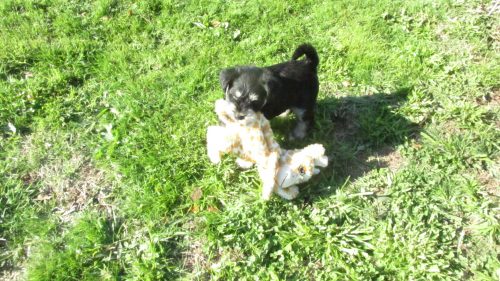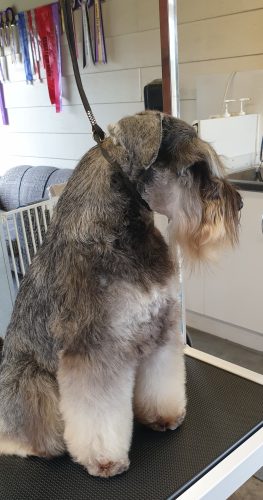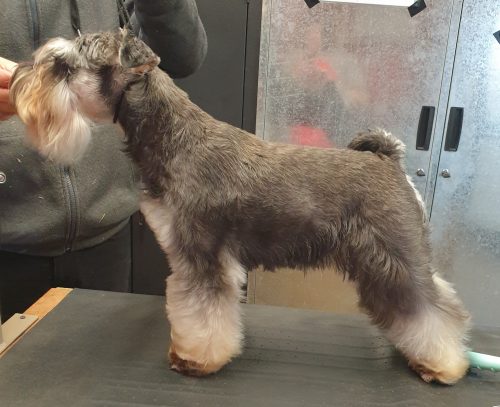Miniature Schnauzer Health
The fat content of your miniature schnauzer’s diet is crucial to prevent pancreatitis.
We advise on the fat % and preventive measures.
How to care for your miniature schnauzer’s teeth
Teeth we help with advise on foods you can feed to help keep your miniature schnauzer’s teeth stay healthy. We do recommend regular cleaning too.
DNA Testing for miniature schnauzers
We DNA test our breeding dogs for the relevant problems for miniature schnauzers. These tests are recognised by miniature schnauzer breed clubs and are in consultation with other miniature schnauzer breeders around the world as conditions that affect miniature schnauzers. We are happy to advise on the right tests for miniature schnauzers.
Do miniature schnauzers have different needs at different ages?
With many years experience with miniature schnauzers we are able to advise you on keeping your miniature schnauzers healthy through all life stages. We were very sad to lose our elderly (16 years young) boy. We have a few tips that really help through those precious years.
 Toilet Training your Miniature Schnauzer
Toilet Training your Miniature Schnauzer
The earlier the better. We use a method called imprinting we let our puppies know that the grass is the place to use to toilet. We DO NOT use pee pads confusing miniature schnauzer puppies into thinking that peeing in the house is acceptable. We do most of the hard work with toilet training your miniature schnauzer puppy, rain, sun, day and night. So you can enjoy your miniature schnauzer puppy and spend time playing. We advise on how to successfully continue this toilet training on.

Socialising your Miniature Schnauzer Puppy
It is important to socialise your miniature schnauzer puppy at an early age in a safe manner and then to continue to do this as they move through the teenage stage. We are happy to advise on socialising your miniature schnauzer puppy, so you will get a well rounded dog that you can take anywhere.
Feeding your Miniature Schnauzer Puppy
It is important to give your miniature schnauzer puppy the right manners around food we start this by teaching them to calmly sit for their food. We can advise on how to continue this. Schnauzinn Kennel miniature schnauzer puppies are not fussy eaters.
Feeding the right good quality food to your miniature schnauzer ensures good health and helps them to live longer. We do have foods we recommend and foods to avoid.
Crate Training your Miniature Schnauzer puppy
A crate is not a jail it is like giving your miniature schnauzer puppy a bedroom this is their safe zone. Make this a pleasant experience and have only positive associations with your miniature schnauzer’s crate. We start this training off and help you to continue this positive experience.
Training your Miniature Schnauzer puppy
Miniature schnauzer puppies are very bright and learn quickly. However you need to be careful that they don’t train you in their ways. We will help by starting their training off by teaching them to sit for attention. We will advise and guide you to continue this training on.

Is it cruel to hand strip a miniature schnauzer?
Not if it is done probably the hair has a life cycle and taking the hair in a non growth cycle is not painful for the dog. In fact adult dogs will lie down and sleep, puppies are short sessions like anything until they learn to stand or lie quietly. It is the same as when you brush your hair and the hair that comes out in your hair brush has caused you no pain.
We have a qualification for hand stripping and can give you advise on this if you wish to have the true double coat on your schnauzer. Even if you choose to clip your dog you should still have a basic knowledge of the coat, to prevent what ones call schnauzer bumps which are rare in a hand stripped coat.
Grooming your miniature schnauzer
Puppies need to be started young to be taught to be good to groom. We start our puppies off at 4 weeks old with their first mini clip and again at 8 weeks old so they go home tidy at 9 weeks old.
We then show our families how to brush their puppy and train their puppy for their groomer. We offer free videos on our schnauzinn pups Facebook page for our families. These have covered how to bath properly, hand strip and any other requested grooming videos.
Our information book has a whole section on grooming instructions with pictures. This is a bound information booklet so it stays together and tidy.
For those that may like to learn to either hand strip or to clip their own dogs we are happy to offer lessons either as a small group or an individual






